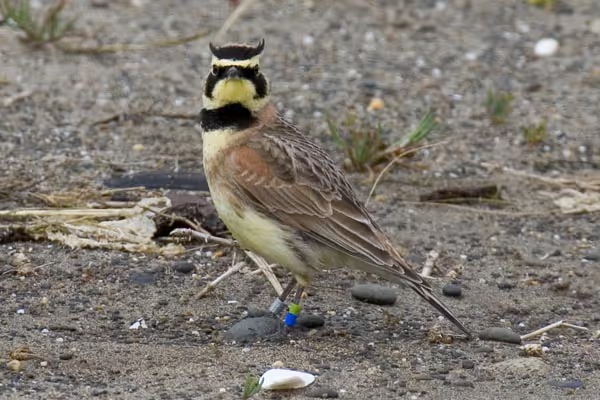Streaked Horned Larks and Damon Point’s Protection Efforts


Walk far enough along Damon Point and you’ll see signs instructing you to stay out of the dunes between March and September. As for your four-legged companions, they aren’t allowed past the signs at all; not even on the beach. This might seem strict, but it is quite necessary to protect a rare bird species that uses Damon Point as a nesting site.
The streaked horned lark (Eremophila alpestris strigata) is a federally threatened subspecies of horned lark. They are 6-8 inches in length and have a dark brown back, lighter brown napes, and yellow faces, heads, throats, and breasts. They are distinguished from other species of horned larks by their vibrant coloration, especially on the back and breast. Males have the “horns” characteristic of their species.
As a whole, horned larks are quite widespread, but this particular subspecies can only be found in the Pacific Northwest. Historically, they ranged from British Columbia to the Umpqua and Rogue River Valleys of southwestern Oregon. In Washington, they could be found throughout the entire coast, in the San Juan Islands, and the Puget Lowlands.
However, this is no longer the case. Currently, they can only be found between Grays Harbor and the Willamette Valley of northwestern Oregon. U.S. Fish and Wildlife estimates the streaked horned lark population to be 1,170-1,610 individuals as of 2011, the majority of which are located in the Willamette Valley. In Washington, they can be found along the coast from Damon Point to Cape Disappointment, in the Puget Lowlands, and on Lower Columbia River islands. In 2015, Washington Fish and Wildlife reported an estimated 147 breeding pairs in 17 known sites throughout the state (Stinson 2015).
The streaked horned lark nests in wide open spaces with few trees and shrubs, such as grasslands, prairies, and dunes. They prefer sites with no vegetation or vegetation no more than a few inches tall and that are at least 300 acres in size. As such, they can often be found in airports, agricultural fields, or near water.
Nesting begins in March when the larks break from their flocks into breeding pairs. The male larks are responsible for selecting and defending their territory. The female larks are responsible to nest building and incubation. Both parents are responsible for feeding and tending to the young.
Nests are made of fine vegetation in a depression in the ground. If a natural depression is not available, the female will make one herself. Incubation lasts for about 12 days and clutches usually contain 1-5 eggs. After hatching, the young will remain in the nest for about 7-9 days. They leave before their feathers are fully formed and are only learn to fly about two weeks after fledging. Because the incubation and nesting periods are so short, many pairs will re-nest during the season.
Once the breeding season has ended, the larks will gather and form flocks, sometimes with other bird species such as the American pipit. Some larks (the Puget Lowland population in particular) will migrate south for the winter while others remain at the breeding site year-round (Anderson and Pearson 2015).
In the winter, streaked horned larks feed primarily on seeds. During the nesting season they add invertebrates to their diet as this is what they feed their young. However, they don’t have strong food preferences and do not choose their habitat based on the availability of a specific food source.
Streaked horned larks face a number of threats. They have many predators to watch out for, some of which include crows, red-tailed hawks, great horned owls, garter snakes, coyotes, raccoons, opossums, and domestic dogs and cats. They also suffer from habitat loss, often due to human development, but the encroachment of trees and non-native plants like scotch broom also pose a threat. In addition, since known nesting sites are often in manmade environments, they are subject to threats from human disturbance, such as mowing or pesticide use.

As Damon Point has become more popular over the years, protection efforts have become increasingly necessary. In addition to removing invasive plant species, the Department of Natural Resources has banned dogs from entering protected areas. According to Birdie Davenport, lead spokesperson for the DNR on the management of Damon Point, “Dogs and ground-nesting birds really don’t mix” and leash laws throughout the park would not provide the birds enough protection (Bruscas 2014).
Thankfully, you and your four-legged friends can enjoy the expanse of beach near the park’s entrance together. And the streaked horned larks can breathe a little easier knowing the Damon Point dunes will remain a great place to nest.
References
Anderson, H. E., & Pearson, S. F. (2015, April). Streaked Horned Lark Habitat Characteristics. Retrieved September 01, 2020, from https://thurstonhcp.files.wordpress.com/2018/11/streaked-horned-lark-habitat-characteristics_april-2015.pdf
Bruscas, A. (2014, June). DNR explains Damon Point signs, protection efforts. Retrieved August 31, 2020, from https://web.archive.org/web/20140820201830/http://northcoastnews.com/news/dnr-explains-damon-point-signs-protection-efforts.html
Stinson, D. W. (2015, December). Washington State Periodic Status Review for the Streaked Horned Lark. Retrieved September 2, 2020, from https://wdfw.wa.gov/sites/default/files/publications/01774/draft_wdfw01774.pdf
U.S. Fish and Wildlife Service (n.d.). Streaked Horned Lark. Retrieved September 01, 2020, from https://ecos.fws.gov/ecp/species/7268
Image 1 Copyright David Maloney/USFWS
© Laura Caldwell, September 2020
Touch whale bones, examine shipwreck artifacts and connect with the coast's living history.

Support our mission, get involved in educational programs, or contribute through donations and volunteering.